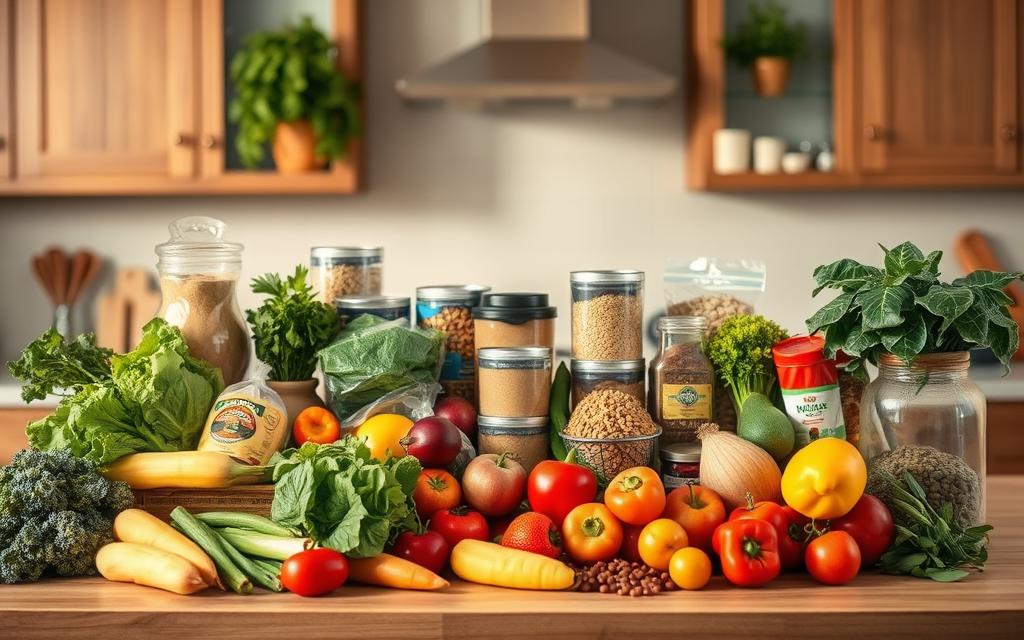Advertisement
The average American household spends nearly $4,000 a year on groceries. This is a big part of the family budget. But, adopting a few simple strategies can lead to big savings.
Learning to shop smart doesn’t mean you need to clip coupons. By knowing what you need, planning meals, and shopping wisely, you can cut down on costs.
Good frugal shopping tips include planning meals with seasonal produce and buying in bulk. These steps help reduce waste and lower your grocery bills.
By using these easy tips, families can save money on groceries without coupons. This makes a big difference in their budget.
Understanding Your Grocery Budget
To save money on groceries, you need to understand your budget. It’s important to manage your grocery expenses well. This means analyzing your spending, setting financial goals, and tracking your expenses.
Analyzing Your Current Spending
Start by looking at how much you spend on groceries. Check your past receipts and bank statements. This will show you where your money goes and where you can save.
Setting a Realistic Budget
After understanding your spending, set a realistic grocery budget. Think about your diet, preferences, and family size. A good budget includes room for treats and surprises, making it doable and lasting.
Tracking Your Grocery Expenses
Keep track of your grocery spending to stay on budget. Use a budget app or spreadsheet to monitor your spending. This way, you can adjust your spending to meet your budget-friendly groceries goals.
By sticking to these steps, you can save a lot on groceries. This careful budgeting not only cuts down your grocery bills but also improves your overall finances.
Meal Planning Basics
One of the best ways to save money on groceries is by using affordable meal planning. Planning your meals ahead of time helps you avoid expensive takeouts. It also cuts down on food waste, saving you cash.
Meal planning is more than just picking dinner. It’s about making a plan that uses what you already have. This way, you don’t need to buy as much.
Importance of Meal Planning
Meal planning is key to keeping your grocery costs down. It stops you from buying things on impulse. It also makes sure you use up all your ingredients, saving money and reducing waste.
Planning meals around what’s on sale at the store can also save you money. Having a plan helps you make a better shopping list. This makes shopping faster and more efficient.
How to Create a Weekly Meal Plan
To make a weekly meal plan, follow these steps:
- Check what you already have in your pantry, fridge, and freezer.
- Plan meals using what you already have.
- Look at the weekly ads for your local stores to see what’s on sale.
- Make a shopping list based on your planned meals and sales.
Here’s a simple example of a meal planning table:
| Day | Meal | Ingredients Needed |
|---|---|---|
| Monday | Pasta with Tomato Sauce | Pasta, Tomatoes, Garlic, Olive Oil |
| Tuesday | Grilled Chicken with Vegetables | Chicken Breast, Mixed Vegetables, Olive Oil |
| Wednesday | Lentil Soup | Lentils, Vegetables, Broth |
Utilizing Leftovers Efficiently
Using leftovers is a big part of meal planning. It cuts down on waste and stretches your money further.
To use leftovers well, try these tips:
- Plan meals that use similar ingredients to make leftovers easier.
- Freeze leftovers for later meals.
- Get creative with leftovers by turning last night’s dinner into tomorrow’s lunch.
By using these smart shopping strategies in your meal planning, you can save a lot on groceries. You’ll also reduce food waste.
Smart Grocery Shopping Strategies
To save money on groceries, you need a smart plan. Being aware of your shopping habits and making small changes can cut your bills a lot.
Making a Detailed Shopping List
Start with a detailed shopping list. Plan your meals for the week before you go shopping. This helps you know what you need and avoid buying too much.
Here’s how to make a good list:
- Check what you already have at home to avoid duplicate purchases.
- Plan your meals around what’s on sale at the store.
- Include quantities to help you stick to your needs.
Stick to Your List: Avoiding Impulse Buys
It’s important to stick to your list to avoid impulse buys. These extra purchases can quickly add up and waste your money. By focusing on your list, you save money and reduce waste.
“Shopping without a list is like going on a road trip without a map; you’re likely to get lost and end up somewhere you didn’t intend to be.”
To stay on track, try these tips:
- Set a budget and track your spending.
- Avoid shopping when you’re hungry or distracted.
- Use cash instead of credit cards to make the spending feel more real.
Choosing the Right Time to Shop
When you shop can also save you money. Buying during sales or when stores offer discounts can cut costs on what you need.
Here’s a look at savings at different times:
| Shopping Time | Potential Savings | Tips |
|---|---|---|
| During weekly sales | Up to 20% off | Stock up on non-perishables |
| End-of-season clearance | Up to 50% off | Buy fresh produce in season |
| Digital coupon days | Varies | Use store apps to load coupons |
By using these smart shopping tips, you can save a lot on groceries. It’s all about being informed, planning, and making smart choices while shopping.
Understanding Pricing Strategies
To cut down on grocery costs, it’s important to grasp how prices are set. Stores use different pricing tactics to draw in customers and boost sales. Knowing these strategies can help you save money.
Identifying Unit Pricing
Unit pricing is key in grocery shopping. It shows the cost per unit, like ounces or pounds. Look for the unit price tag on the shelf, below the regular price tag.
For example, when comparing two cereal sizes, check the unit price. This helps you pick the better deal and save money.
| Product | Price | Unit Price |
|---|---|---|
| Cereal A (12 oz) | $3.50 | $0.29/oz |
| Cereal A (20 oz) | $5.50 | $0.275/oz |
Recognizing Sale Patterns
Stores put items on sale to boost sales and clear out stock. Knowing sale patterns helps you buy your favorites at the best prices.
Some stores have a sale rotation, where certain items are discounted on specific days. By spotting these patterns, you can plan your shopping to catch the best deals.
“The key is not to prioritize what’s on your calendar but to put on your calendar what’s a priority.” – Stephen Covey
The Impact of Store Brands vs. Name Brands
Store brands, or private labels, are made by a third party and sold under the store’s name. They’re often cheaper than name brands but just as good.
For instance, store-brand milk or canned goods can be 20-30% cheaper. Choosing store brands can save you money without lowering quality.
By understanding pricing strategies, like unit pricing and sale patterns, you can save on groceries. Using these tips can lead to big savings over time, helping you reach your financial goals.
Seasonal Shopping Benefits
Shopping for groceries in tune with the seasons can cut down your expenses. By knowing what’s in season, you can plan meals and make a better shopping list. This way, you get fresh produce at lower prices.
Understanding Seasonal Produce
Seasonal produce is not only cheaper but also tastes better. Knowing what’s in season helps you plan meals and save money. For instance, buying strawberries in May or pumpkin in October is cheaper than buying them out of season.
Planning Around Seasonal Sales
Seasonal shopping lets you plan around sales. Grocery stores often discount seasonal produce, which is a great time to buy. By planning meals and shopping lists around these sales, you can save more.
Here’s how seasonal sales can affect your shopping:
| Season | Produce | Average Price (In Season) | Average Price (Out of Season) |
|---|---|---|---|
| Spring | Strawberries | $2.50/lb | $4.50/lb |
| Fall | Pumpkin | $1.50/lb | $3.00/lb |
Preserving Seasonal Foods for Later
Preserving seasonal foods is a smart way to enjoy your favorites all year. Methods like canning, freezing, and dehydrating keep produce fresh. This way, you can enjoy seasonal foods even when they’re not in season.
By using these strategies, you can enjoy budget-friendly groceries and follow frugal shopping tips. These tips can really help your household budget.
Bulk Buying Wisely
Purchasing items in bulk can save you a lot on your grocery bill. But, it’s important to know what you need and how much you can use.
Buying in bulk works best for non-perishable items you use often. This way, you avoid buying at high prices and shop less often.
Best Items to Purchase in Bulk
Not all products are good for buying in bulk. The best are non-perishable items like canned foods, pasta, rice, and household supplies. These items last a long time and don’t spoil easily.
- Canned goods and soups
- Pasta, rice, and other grains
- Oils and spices
- Household supplies like toilet paper and paper towels
Assessing Storage Needs for Bulk Items
Before buying in bulk, check if you have enough space. Make sure your pantry, cupboards, or storage areas can hold the bulk items without getting cluttered.
Think about these when checking your storage:
- Available storage space
- Shelf organization and accessibility
- Potential for clutter or disorganization
Cost-benefit Analysis of Bulk Purchases
To see if buying in bulk saves money, do a cost-benefit analysis. Compare the price per unit of the bulk item to the regular price of the same item in smaller sizes.
| Item | Bulk Price | Unit Price | Regular Price |
|---|---|---|---|
| Pasta (12 lbs) | $15 | $1.25/lb | $2/lb (regular) |
| Rice (20 lbs) | $25 | $1.25/lb | $1.50/lb (regular) |
As the table shows, buying pasta and rice in bulk can save a lot of money per unit compared to buying smaller amounts.
“The key to successful bulk buying is not just about purchasing large quantities, but about making smart, cost-effective decisions that align with your consumption habits.”
By choosing the right items, checking your storage, and doing a cost-benefit analysis, you can make bulk buying a smart part of your shopping. It helps you save money and shop wisely.
Utilizing Technology for Savings
In today’s world, technology helps us save money on groceries. It offers many digital tools and platforms. These make shopping for groceries cheaper and easier.
Grocery Budgeting Apps
Grocery budgeting apps help track spending and stay on budget. Apps like Mint and YNAB (You Need a Budget) let users monitor their spending. They also help set budget goals and send alerts when you’re close to your limit.
These apps are great for finding ways to save money. They help spot where you can cut back on unnecessary costs.
Some key features of these apps include:
- Expense tracking
- Budget setting
- Alerts for overspending
- Receipt scanning
Price Comparison Tools Online
Price comparison tools help find the best deals. Websites and apps like Flipp and Checkout 51 compare prices across stores. This ensures you get the best value for your money.
Digital Loyalty Programs
Digital loyalty programs offer rewards and discounts to loyal shoppers. Many stores have apps, like Kroger’s Plus Card and Walgreens’ Balance Rewards. These apps give personalized offers and savings based on your shopping habits.
To save more, it’s key to:
- Sign up for many loyalty programs
- Use digital coupons
- Keep an eye on weekly deals
Using these tech tools can greatly lower your grocery bills. Adopting digital solutions makes grocery shopping more efficient and affordable.
Cooking at Home vs. Eating Out
Choosing between cooking at home and eating out is key to saving money. Cooking at home lets you control what you eat, how much, and how much it costs.
Cost Analysis: Home Cooking vs. Restaurant Meals
Home cooking beats dining out in cost. A meal at home can cost just $3 per serving. But, a meal at a mid-range restaurant can be over $15 per person.
Home cooking is not only cheaper but also healthier. It helps you avoid expensive, last-minute meals.
Family Meal Prep to Save Money
Preparing meals in bulk for your family can save a lot of money. Cooking big batches reduces waste and cuts grocery bills. It also helps with meal planning, keeping you on track and avoiding impulse buys.
- Plan meals around what’s on sale at the grocery store.
- Use leftovers to reduce food waste.
- Invest in a slow cooker for easy, affordable meals.
Quick and Affordable Recipes
Finding quick, affordable recipes is essential for home cooking. Look for recipes that use common ingredients and can be made in under 30 minutes. These recipes save time and money, making affordable meal planning possible.
Examples include one-pot pasta, stir-fries, and omelets. These meals are cheap and versatile, letting you use different ingredients based on what’s in season and on sale.
Exploring Alternative Grocery Sources
For savvy shoppers, looking beyond the usual supermarket can save a lot. You can find fresher produce and cut down on costs without using coupons.
Farmer’s Markets and Local Producers
Farmer’s markets and local producers let you buy fresh, local produce directly. You can get better quality and sometimes negotiate prices or buy in bulk. This can lead to savings.
- Freshness: Produce is harvested at its peak.
- Variety: You’ll find a wide range of products, including organic and heirloom varieties.
- Community Support: Buying local helps the local economy and farmers.
Buying from Co-ops and Community Supported Agriculture (CSA)
Co-ops and CSAs offer affordable, sustainable produce. Buying directly from farmers or through a cooperative can save money. You also get fresh, sustainably grown produce.
“Joining a CSA or co-op not only supports local agriculture but also provides an opportunity to enjoy seasonal produce while potentially saving on grocery bills.”
| Benefits | Co-ops | CSAs |
|---|---|---|
| Freshness | High | Very High |
| Cost Savings | Potential through bulk buying | Potential through subscription models |
| Community Engagement | High | Very High |
Online Grocery Services and Discounts
Online grocery services are gaining popularity for their convenience and savings. They offer discounts, digital coupons, and loyalty programs. These can help lower your grocery bill.
Key benefits include:
- Avoiding impulse buys by sticking to a digital shopping list.
- Taking advantage of online-exclusive deals and discounts.
- Saving time by having groceries delivered or made available for pickup.
Exploring these alternative sources can make your shopping more varied and cost-effective. You can save money and enjoy fresher, sustainable produce. Options range from farmer’s markets to online services, all designed to make grocery shopping more efficient.
Avoiding Food Waste
Reducing food waste helps the environment and saves money. Being mindful of your shopping and eating habits can cut down on waste.
Understanding Expiration Dates
Knowing about expiration dates is key to avoiding waste. Many think “sell by,” “use by,” and “best by” mean food is unsafe. But, these dates are about quality, not safety.
- Sell by: This date is for the store, showing when to sell the product.
- Use by: It’s when the product is at its best quality.
- Best by: This is when the product tastes or looks its best.
Creative Ways to Use Leftover Ingredients
Being creative with leftovers can cut down waste. Here are some ideas:
- Make tomorrow’s lunch from last night’s dinner in a new way.
- Use leftover veggies for a tasty soup or stew.
- Make croutons or breadcrumbs from stale bread.
By being creative, you can turn leftovers into new meals. This saves money and reduces waste.
Best Practices for Food Storage
Proper storage extends your groceries’ life. Here are some tips:
- Store fruits and veggies correctly. For example, potatoes need a cool, dark spot, while tomatoes prefer room temperature.
- Keep your fridge at 40°F or below to slow bacteria growth.
- Use airtight containers for leftovers to keep them fresh longer.
Following these storage tips helps keep your groceries fresh. This reduces the need for frequent buys and saves money.

Using these strategies can greatly reduce waste and save on groceries. Being mindful of expiration dates, creative with leftovers, and storing food right can lead to budget-friendly groceries and money-saving grocery hacks.
Learning to Cook on a Budget
Learning to cook on a budget can really cut down your grocery costs. It makes shopping for food more fun and affordable. By using simple cooking methods and planning meals wisely, you can make tasty dishes without spending a lot.
Essential Cooking Skills
It’s important to learn basic cooking skills to save money. Techniques like roasting, grilling, and sautéing let you make many dishes with just a few ingredients. Websites like Allrecipes and Food.com have lots of tips on easy cooking.
Affordable Recipe Resources
For budget-friendly recipes, check out Budget Bytes and The Dollar Stretcher. They offer great meal ideas and tips to save on food. These sites help you plan meals, avoid food waste, and cut grocery costs.
Expanding Your Culinary Skills
As you get better at cooking, try new ingredients and recipes. This makes your grocery shopping even more rewarding. By combining smart meal planning with good cooking skills, you can enjoy healthy meals at home without overspending.



